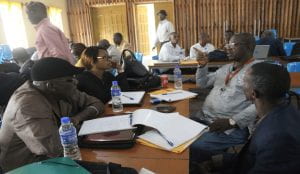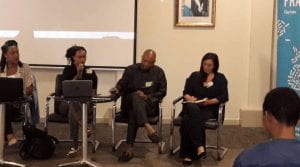Guest blog written by Thierno lliassa Balde

The Guinean tertiary education and Technical Education and Professional Training (TVET) system is dominated by programs that do not meet the needs of the labor market. Inappropriate orientation of training is a major cause of programs’ lack of relevance to business requirements. The system lacks scientific, technical, and professional training opportunities. Graduates rarely develop entrepreneurial skills, as most aspire to enter the public service. Challenges include overstaffing, poor linkages between training institutions and businesses, an over abundance of theoretical courses, dilapidated laboratories, and a lack of practical activities. The result is a very high unemployment rate among young graduates, despite many years of study.
Unemployment is highest among Technical Education and Professional Training (TVET) – 40% and Higher Education graduates -60%. With the exception of large-scale mining companies, the economy is dominated by informal enterprises and low productivity jobs and a skills mismatch between graduates and those demanded by employers.[i]
This problem is politically sensitive (the population of Guinea is young) and it affects the country’s growth as well as its prosperity. Once this problem is solved, it will put an end to the paradox of seeing employers complaining about the lack of skilled labor on the ground to fill the available positions.
Moreover, including entrepreneurial programs in the skill-training will also save most unemployed graduates complaining about the lack of jobs/employment; they can instead use their initiative to create their own enterprise with some kind of support both financially and morally.
For all these reasons, the Government of Guinea and its partner the World Bank, have set up a project to address this problem which will aim to boost the employability and employment outcomes of Guinean youth in targeted skills programs. More specifically, it aims to improve the effectiveness of training programs in universities and vocational institutions, and provide professional opportunities to young, job-seeking graduates by strengthening their skills through training, internships, jobs, or personalized support for business setup.
The project is based on public-private partnership. Its success in terms of impact and sustainability depend on the ability to use standard project management tools, the commitment of the various stakeholders and the quality of the partnership. For all these reasons, these points have been identified as critical and are essential for the sustainability and effectiveness of the project.
The key stakeholders of the unemployment problem are:
- Those most affected by the problem and benefiting from the response are:
- Young graduates with no skills (Associations unemployed)
- Individual unemployed youths (current graduates, as well as youth ‘trapped’ outside of labor market)
- Private sector and SMEs represented by : Mining Chamber, Agriculture Chamber, Industry Association, and Tourism and Hospitality Federations,…
- Parents
- Education system (Training institutions.)
- Those authorizing a response are mostly government agencies listed as follows
- Government (Ministry, Agency)
- Ministry of Youth and Youth Employment
- Ministry of Industry and Small and Medium Enterprises
- Ministry of Higher Education and Scientific Research
- Ministry of Technical and Vocational Training etc.
- Private sector (Mining Chamber, Agriculture Chamber, Industry Association, and Tourism and Hospitality Federations,…)
- World Bank
- Those identifying responses are technical service agencies such Strategy and Development Office, Public Employment Service Agency, etc. and other experts mandated for this purpose by either the concerned government authorities or the donor agencies involved.
- Those in charge of implementing the response may include:
- Project Implementation Unit (PIU) in charge of project implementation
- Other prominent training centers and incubators in collaboration with Fund dedicated to youth employability development) under the PPP schemes will also have a role to play in the implementation.
This kind of initiative has been successful in some countries, with time-limited design and implementation under specific frameworks. The design of the project is innovative, complex and involves several stakeholders and a paradigm shift in relation to the local context.
Considering all these factors reduces the flexibility in project implementation. It was necessary to expand the possibilities for action and find complementary tools to those existing.
During the implementation of this project, one of the problems identified was the effective involvement of the various stakeholders.
As Project Manager, I am responsible for the overall management of the policy. I must negotiate with key stakeholders and make sure that each facet of each issue is effectively dealt with before implementation. Furthermore, I must monitor progress as well as the longevity of the outcome or result. I hold a key role in making the initiative as worthwhile as desired.
In this context, I began to explore how I could facilitate and improve project implementation in line with its framework and objectives.
The PDIA method seemed to me to be the most appropriate Tool for the implementation issue we are facing. I needed to use such a tool to improve the performance within the framework and objectives of the project.
Right from the beginning of the IPP program, I felt comfortable, as I met a wonderful team of experienced trainers familiar with public policy issues, especially those in developing countries, and pairs of students from different backgrounds with different experiences. It made me comfortable and strengthened my choice to attend this class.
With this training I have gotten a new approach to solve simple or complex problems in my daily work.
After my on-campus training and the acknowledgement that the effective involvement of stakeholders in the project is a problem, the government with its partner requested our team to do its utmost to change the situation. We used this as an entry point for action. The idea we immediately started working on was the weakness of stakeholder dialogues. Our aim was to improve the dialogue between stakeholders: young people (unemployed and students), companies in the university system and associations and chambers of SMEs, the government, in order to deconstruct the problem. First, we identified the team members of each stakeholder, then we scheduled meetings between them. This is a useful approach which can be easily implemented, to facilitate deconstructing the problem.
I started to use and share with my team the PDIA approach and tools. These tools allowed us to integrate the context in order to find local solutions to local challenges and then work iteratively to learn and adapt before generalizing.
As part of our project’s activities, we conducted a capacity building activity for the beneficiaries (universities and private sectors). I took this opportunity to use the PDIA approach to identify problems and provide solutions in a participative manner with stakeholders.
One of the immediate benefits of this approach is to to speak openly and address the real challenges, free from the risk of being judged.

Deconstructing the problem: a participative diagnosis of the difficulties encountered by stakeholders was carried out. The main issues identified included ; governance (dysfunction of the steering committee), coordination, partnership, design and sizing of activities, internal and external communication, team management (delegating, motivating,…) poor dialogue between the stakeholders.
Partnership issues

Management issues

Relational Mapping

Our mid-term goal is to bring together the relevant stakeholders in a single working forum. We are working under the leadership of the government, its partner, the World Bank, in collaboration with the private sector, to organize this meeting in order to improve dialogue and the partnership between the project’s stakeholders (universities, private sector, Public Employment Agency, etc.).
Before the forum we had meetings that allowed us to strengthen public-private dialogue and partnerships, such as;
- Partnership agreement with the Total Guinea group for the internship of 200 unemployed young graduates registered in the database of the Guinean Public Employment Service Agency

- Meeting with the executive team of Patrice Lumumba Polygraph Industrial Complex (CIP-PL)

- Employability workshop

To conclude, I would like to share some of the lessons I have learned from this experience, namely :
Listening
This experience allowed me to understand how crucial it is to communicate and how important it is to listen to partners in order to take care of their concerns.
Involving various stakeholders
To better involve the various stakeholders, I have opted for power sharing with the heads of the components by giving them more autonomy and flexibility in the implementation of their activity, while ensuring that there is no mismanagement in the process. This has allowed better collaboration and successful implementation of an innovative and highly complex programme in the context of Guinea. In PIU I try to value my employees by giving them maximum autonomy and valuing their work and the results obtained.
Motivation
The most difficult aspect of the work I have done is to bring about lasting change in the established habits … The methods I usually use to motivate myself and others to continue doing challenging things is always telling myself that the policy in question (training the young people well) can make a real change and have a real impact on the daily life of the population.”
We are indeed working on a project which will have a positive impact on human capital and will therefore strengthen the capacity of the State to solve the problems of the population and better serve it. I was able to convince the team that this project is strategically very important for our country. A well-educated population is crucial to the development of our country.
This is a blog series written by the alumni of the Implementing Public Policy Executive Education Program at the Harvard Kennedy School. Participants successfully completed this 7-month blended learning course in December 2019. These are their learning journey stories.
To learn more about Implementing Public Policy (IPP) watch the course and testimonial video, listen to the podcast, and visit the course website.
[i] World Bank. 2014. Project Appraisal Document : Guinea, Stepping Up Skills Project.